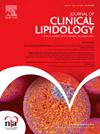陈去氧胆酸治疗脑黄疽成人患者的评估:一项随机、安慰剂对照的3期研究
摘要
研究经费Mirum Pharmaceuticals, Inc.背景/简介脑膜黄瘤病(CTX)是一种罕见的胆汁酸合成代谢性疾病,由编码甾醇27-羟化酶的CYP27A1基因的双倍性致病变异引起,导致胆汁酸合成异常以及胆甾醇、胆汁醇和其他代谢产物的毒性蓄积。目标/目的我们在第一项3期随机停药、双盲(DB)、安慰剂(PBO)对照、两阶段x两治疗交叉研究(RESTORE)中评估了CDCA对CTX生物标志物的疗效和安全性。方法在成年 CTX 患者(≥16 岁)中开展了一项为期 24 周的随机停药、DB、交叉研究,并进行了 30 天的安全性随访,这些患者在研究的两个 8 周开放标签 (OL) 期接受 250 毫克 CDCA TID,并在两个 4 周 DB 期接受盲法 CDCA 或 PBO。符合条件的参与者须经临床诊断并经生化证实患有 CTX,无已知的吸收不良或消化道疾病,且未服用胆酸和/或影响胆汁酸吸收的药物。主要终点是尿胆汁醇生物标志物 5β-胆甾烷-3α,7α,12α,23S,25-戊醇(23S-pentol)从基线(BL)到每个 DB 治疗期结束时的变化。关键的次要疗效终点包括:每个 DB 治疗期结束时血浆胆甾醇和 7α-hydroxy-4-cholesten-3-one (7αC4) 的变化百分比,以及 DB 治疗期间需要抢救药物 (CDCA) 的患者比例。结果分析纳入了 14 名参与者,入组时的中位(最小,最大)年龄为 41.5(16,55)岁,大多数为白人男性,所有患者均被临床诊断为 CTX,并经生化确诊。在 OL 治疗期后停用 CDCA 会导致尿液中 23S-pentol (ng/mL) 增加 20 倍(95% CI:10.3, 43.5 p<0.0001),尿液中 23S-pentol (ng/mL) 增加 2.8 倍(95% CI:10.3, 43.5 p<0.0001)。血浆胆甾醇(µg/mL)增加 8 倍(95% CI:1.5,5.2;p=0.0083),血浆 7αC4(ng/mL;安慰剂相对于 CDCA)增加 50 倍(95% CI:25.0,66.7;p<0.0001)。相当一部分服用 PBO 的参与者(61.5% [95% CI:31.6, 86.1];p=0.0006)在 DB 停药期间需要使用盲法抢救药物。CDCA最常报告的TEAEs是腹泻(5例)和头痛(3例),大多数为轻度至中度,不认为与治疗有关。CDCA 治疗耐受性良好,能有效抑制 CTX 中异常胆汁酸合成,防止胆甾醇和胆汁醇的积累。这凸显了 CDCA 帮助 CTX 患者避免疾病恶化的潜力。Study Funding
Mirum Pharmaceuticals, Inc.
Background/Synopsis
Cerebrotendinous xanthomatosis (CTX) is a rare metabolic disorder of bile acid synthesis caused by biallelic pathogenic variants in the CYP27A1 gene, encoding the sterol 27-hydroxylase enzyme, which leads to abnormal bile acid synthesis and toxic accumulation of cholestanol, bile alcohols and other metabolites. Chenodeoxycholic acid (CDCA) treatment is considered the standard-of-care for CTX.
Objective/Purpose
We evaluated the efficacy and safety of CDCA on biomarkers of CTX in the first Phase 3, randomized withdrawal, double-blind (DB), placebo (PBO)-controlled, two-period x two-treatment cross-over study with rescue medication (RESTORE).
Methods
A 24-week randomized withdrawal, DB, crossover study with a 30-day safety follow-up was conducted in adult patients (≥16 years of age) with CTX who received 250 mg CDCA TID for two 8-week open label (OL) periods of the study and either blinded CDCA or PBO for two 4-week DB periods. Eligible participants had a clinical diagnosis of CTX with biochemical confirmation, no known malabsorption or GI conditions, and not on cholic acid and/or medication impacting bile acid absorption. The primary endpoint was change in the urinary bile alcohol biomarker 5β-cholestane-3α,7α,12α,23S,25-pentol (23S-pentol) from Baseline (BL) to the end of each DB treatment period. Key secondary efficacy endpoints included: percent changes in plasma cholestanol and 7α-hydroxy-4-cholesten-3-one (7αC4) at end of each DB period and proportion of patients requiring rescue medication (CDCA) during the DB periods. Safety parameters were also assessed.
Results
The analysis included 14 participants with a median (min, max) age at enrollment of 41.5 (16, 55) years, the majority were white males, and all had a clinical diagnosis of CTX with biochemical confirmation. CDCA withdrawal after the OL treatment period resulted in a statistically significant 20-fold increase (95% CI: 10.3, 43.5 p<0.0001) in urine 23S-pentol (ng/mL), a 2.8-fold increase (95% CI: 1.5, 5.2; p=0.0083) in plasma cholestanol (µg/mL), and a 50-fold increase (95% CI: 25.0, 66.7; p<0.0001) in plasma 7αC4 (ng/mL; placebo relative to CDCA). A significant proportion of participants on PBO (61.5% [95% CI: 31.6, 86.1]; p=0.0006) required blinded rescue medication during the DB withdrawal periods. Most commonly reported TEAEs on CDCA were diarrhea (n=5) and headache (n=3) with the majority mild to moderate in severity and not considered treatment related.
Conclusions
Withdrawal of CDCA treatment led to significant increases in CTX biomarkers. CDCA treatment is well-tolerated and can effectively suppress abnormal bile acid synthesis in CTX, preventing accumulation of cholestanol and bile alcohols. This underscores the potential for CDCA to help CTX patients avoid disease progression.

 求助内容:
求助内容: 应助结果提醒方式:
应助结果提醒方式:


